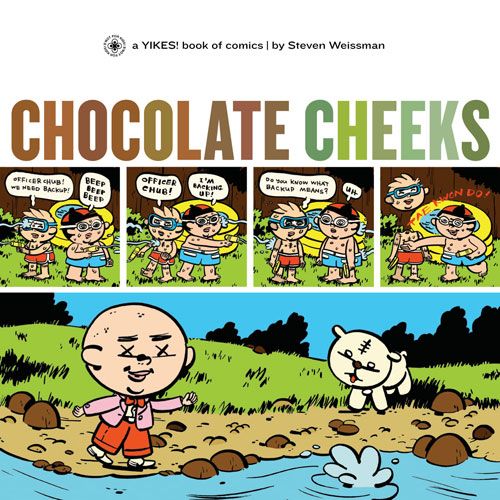The simplest way to determine if you'll enjoy Steven Weissman's "Chocolate Cheeks" is to read the fifth strip in the book. "Sweet" Chubby Cheeks and Pullapart Boy are on the bus and the latter boy gives up his seat to a lumpy-faced man with a cane, causing the man to say "A seat on the 217 bus? Thank you, sir. This brain tumor is the gift that just keeps on giving." When reading, I laughed quite hard, causing my girlfriend to inquire about what was so funny and, upon learning, gave me a "I'm in love with a really weird guy" look. Obviously, "Chocolate Cheeks" isn't for Michelle, but is definitely for me and anyone who likes this sort of twisted, somewhat sick humor.
This collection, which continues Weissman's "Yikes" series of stories, is made up of roughly equal parts four-panel strips and a longer story, "Blue Jay." The stories follow, primarily, "Sweet" Chubby Cheeks and Pullapart Boy, two kids who both loathe and love one another (primarily loathe), but still hang out together, because that's what you do when you're a kid and there aren't a lot of other people to spend time with. Joining them are a bunch of equally weird kids like Dead Boy, X-Ray Spence (who wears X-ray glasses), and Crustache. Crustache is a fantastic spin on a character like Pigpen from "Peanuts," that weird, gross character; instead of being filthy, Crustache has a greenish 'mustache' of crusted snot and blood on his face, utilized best in a strip where two girls won't go skating with him, so he decides to clean himself up by waxing his crustache with earwax.
While half of the book consists of four-panel strips, they don't follow a necessarily traditional pattern of comics strips. Not ever strip has an obvious punchline, some preferring to be mood pieces and little observations. Then again, some of the funniest strips are the ones without an obvious punchline and are simply funny throughout the strip, beginning to end. Like many other comics strips, there are a few recurring ideas like "Sweet" Chubby Cheeks praying "that God will give me the strength to vanquish my enemy," an enemy that turns out to be Pullapart Boy, leading to the two boys praying at the same time against one another. Or, Pullapart Boy helping X-Ray Spence find a nemesis. But, most strips are wonderful little moments of joyful and mean-spirited comradery between the boys.
The strips half of the book is presented in color, which Weissman uses to great effect. He sticks with solid colors, but changes things up in the middle of strips often and also uses the colors to give the art a simple, almost retro feel that matches his art. In a few panels, he works without colors extensively, like one where he just changes the color of the line work on the characters from black to red, or one where only Dead Boy is in color despite the focus being on "Sweet" Chubby Cheeks and Pullapart Boy in the background. In his actual art, he makes these sort of choices often as he puts scenes in seemingly random locations or has the characters dress in strange outfits without explanation. By not providing a context for these choices, it adds to the idea that we're getting small glimpses into the lives of these characters. Explaining the locations or outfits would ruin that effect.
Weissman's drawings are reminiscent of early Charles Schulz, with thick, bold lines, and simply-designed characters. He uses heavy blacks and often draws his characters with small, squinting eyes. The characters have a mix of wholesome simplicity and a slightly off-kilter messiness. When we see characters' eyes open, they look somewhat creepy, and characters often have inexplicable black marks on their faces. In the four-panel strips, Weissman also sticks to very little character movement, repeating poses or panels outright numerous times to great effect, making any changes stand out, but also adding to that sense I mentioned of the character simply standing around with us as voyeurs into their lives.
"Blue Jay" is different from the strips with its lack of color and lack of a focus on those small little funny moments, telling the story of "Sweet" Chubby Cheeks, Pullapart Boy, and Dead Boy as they find that Pullapart Boy's dog has killed a kitten. Discovering that there are more than one kitten (after the dog kills another), they take it in, and get paranoid when they hear noises late at night as Weissman calls back to a joke made in one of the strips. The story is less effective than the strips, but it's still engaging and has numerous funny moments. The ending is downright chilling and made me laugh, but not in a way I'm proud of exactly.
If sound effects like "SNEEZEBLOOD!!" or prayer fights make you laugh, "Chocolate Cheeks" by Steven Weissman is definitely up your alley. More than that, Weissman's fantastic art is worth giving this collection a look even if you haven't read previous "Yikes" books.

